You are using an out of date browser. It may not display this or other websites correctly.
You should upgrade or use an alternative browser.
You should upgrade or use an alternative browser.
Maritime Coastal Defence Vessels (MCDVs)
- Thread starter x-grunt
- Start date
- Reaction score
- 16,481
- Points
- 1,160
Oldgateboatdriver said:I captained Rally for a while, well, OIC'd as they were considered tenders in the Navy, not commissioned ships.
I served on the Ready and Racer, we did 2 weeks on, 2 weeks off. 6hrs on 6 off and then switched to 12 on 12 off. As I recall we crewed with 11 people. An interesting ride in 80kts off of the North end of Vancouver Island!
- Reaction score
- 12,038
- Points
- 1,160
Further to ERC's question about the budget for the STX Protector proposed by OGBD:
According to this article 500 MNZD (408 MUSD) bought the RNZN the 9000 tonne Canterbury (arguably broadly similar to the Danish Absalon but with less offensive capability), two of the 1900 tonne and 85m Protectors (Otago and Wellington) and four of the 340 tonne and 55m inshore vessels.
According to Wiki the Canterbury cost 130 MNZD (105 MUSD current) while the IPVs cost 4x 36 MNZD (117 MUSD current). That leaves the 85m vessels at 408-222 or 186 MUSD the pair or 93 MUSD each.
Interesting question: Which gives Canada more international heft? 4 CSCs at 500 MCAD each or 4 Flotillas similar in composition to the RNZNs fleet. Taking 4 CSCs off the board would still leave 11 or 12 Heavies on the board. The dynamics would be more interesting if the Canterburys were replaced by Barebones Absalon variants of the CSCs. You then have 15 or 16 Heavy hulls with full suites of weaponry for 11 or 12, 8 of the 85m OPVs and 16 of the 56m IPVs. Manning costs would be down. And you would have 23 or 24 lily pads. Add in the two Berlins and the Karel Doorman and Bob's your uncle. (Although I understand him to be younger).
According to this article 500 MNZD (408 MUSD) bought the RNZN the 9000 tonne Canterbury (arguably broadly similar to the Danish Absalon but with less offensive capability), two of the 1900 tonne and 85m Protectors (Otago and Wellington) and four of the 340 tonne and 55m inshore vessels.
According to Wiki the Canterbury cost 130 MNZD (105 MUSD current) while the IPVs cost 4x 36 MNZD (117 MUSD current). That leaves the 85m vessels at 408-222 or 186 MUSD the pair or 93 MUSD each.
Interesting question: Which gives Canada more international heft? 4 CSCs at 500 MCAD each or 4 Flotillas similar in composition to the RNZNs fleet. Taking 4 CSCs off the board would still leave 11 or 12 Heavies on the board. The dynamics would be more interesting if the Canterburys were replaced by Barebones Absalon variants of the CSCs. You then have 15 or 16 Heavy hulls with full suites of weaponry for 11 or 12, 8 of the 85m OPVs and 16 of the 56m IPVs. Manning costs would be down. And you would have 23 or 24 lily pads. Add in the two Berlins and the Karel Doorman and Bob's your uncle. (Although I understand him to be younger).
- Reaction score
- 6,323
- Points
- 1,260
Thanks for that, Kirkhill, and, in answer to your earlier question: my guesstimate is that we will pay $1Billion+ (maybe ++) for a "heavy" which is why I spit-balled $125 Million for the small combatants/MCDV replacements a few days ago.
It seems to me that ships that come pretty close to my ideal (for building starting in about 2025) are available right now so, hopefully, Canadian yards will be willing and able to replace the MCDVs when the RCN finally decides to scrap them.
It seems to me that ships that come pretty close to my ideal (for building starting in about 2025) are available right now so, hopefully, Canadian yards will be willing and able to replace the MCDVs when the RCN finally decides to scrap them.
- Reaction score
- 12,038
- Points
- 1,160
E.R. Campbell said:Thanks for that, Kirkhill, and, in answer to your earlier question: my guesstimate is that we will pay $1Billion+ (maybe ++) for a "heavy" which is why I spit-balled $125 Million for the small combatants/MCDV replacements a few days ago.
It seems to me that ships that come pretty close to my ideal (for building starting in about 2025) are available right now so, hopefully, Canadian yards will be willing and able to replace the MCDVs when the RCN finally decides to scrap them.
As always I enjoy the exercise.
The problem is not the lack of budget, manpower or technology. All of those exist and can be managed.
I believe the problem is one of managing expectations (a problem known to everyone who has lived through Christmas) and more importantly determining whether the RCN is going to be a full service navy that permits Canada freedom of movement on the High Seas. Or is it going to continue to be an auxiliary force as it was to the RN and is now, to my eye, to the USN. What the sailors do they do very well and have been reasonably well equipped for those tasks. But slotting in the Rainbow and Niobe to the RN's order of battle, or taking the load off the RN's heavies by supplying convoy escorts, or adding ASW screens to USN Carrier Groups is not the same as fielding a force that can act truly independently across a broad spectrum of operations.
And a broad spectrum doesn't have to include Guadalcanal. Adding 1 NZ flotilla to our force mix would broaden our ability to respond.
St-Laurent's navy promised that level of independence but Trudeau sank it. The Bonnie's not coming back but technology has moved on and I believe helos and lilypads and small mother ships and unmanned or autonomous vessels can substitute for much of the capability that previously only a ship like HMCS Bonaventure could supply.
- Reaction score
- 0
- Points
- 280
The heavies are going to cost us $1.5+ billion. $26 billion for 15, equals $1.73 B. Drop it down to 12 and it frees up $5+ billion so we could budget $300 million per corvette and get something nice. I would then do 12 heavies and 12 combatant covettes that can be deployed for anti-piracy/ASW/escort duties pretty much anywhere, as well as handle our coastal waters. There would still be a couple billion left over for 2 amphibious assault ships. This is me just dreaming, of course, but 12 destroyers/frigates, plus 12 combatant corvettes, plus 2 amphibious assaults ships would be a pretty nice looking fleet.
- Reaction score
- 6,323
- Points
- 1,260
Kirkhill said:As always I enjoy the exercise.
The problem is not the lack of budget, manpower or technology. All of those exist and can be managed.
I believe the problem is one of managing expectations (a problem known to everyone who has lived through Christmas) and more importantly determining whether the RCN is going to be a full service navy that permits Canada freedom of movement on the High Seas. Or is it going to continue to be an auxiliary force as it was to the RN and is now, to my eye, to the USN. What the sailors do they do very well and have been reasonably well equipped for those tasks. But slotting in the Rainbow and Niobe to the RN's order of battle, or taking the load off the RN's heavies by supplying convoy escorts, or adding ASW screens to USN Carrier Groups is not the same as fielding a force that can act truly independently across a broad spectrum of operations.
And a broad spectrum doesn't have to include Guadalcanal. Adding 1 NZ flotilla to our force mix would broaden our ability to respond.
St-Laurent's navy promised that level of independence but Trudeau sank it. The Bonnie's not coming back but technology has moved on and I believe helos and lilypads and small mother ships and unmanned or autonomous vessels can substitute for much of the capability that previously only a ship like HMCS Bonaventure could supply.
Now you're talking like Percy Nelles who also wanted a big, "broad spectrum" navy and who, in my opinion, was a
What was needed, as Leonard Murray et al understood, was was absolutely essential, was to win the Battle of the Atlantic, and for that we needed a mix of those cheap, quick and dirty corvettes, frigates and aircraft (land and carrier based). Convoy escort wasn't glamorous but it was one of the three big things that Canada did that really, really mattered; the other two were industrial production and the Commonwealth Air Training Plan.
Our other naval contributions: including the cruisers, fast Tribals, and the brave motor torpedo boats were all distractions.


RAdm Leonard Murray who understood the war & VAdm Percy Nelles who didn't
- Reaction score
- 12,038
- Points
- 1,160
Circumstances.... they define everything.
Taking the load off in the North Atlantic from 1939 to 45 (and 1914 to 18) made sense. There was a war on. Freedom of movement (both political and on the high seas) was constrained by the reality of circumstances. Absolutely no sense in building cruisers and carriers when corvettes, Liberators and Sunderlands were getting the job done.
Even during the Cold War, the threat (and looking back at it now it is harder to believe it was real) was perceived to be real enough that it made sense to function in concert with our allies.
However our current world, and the one coming, not only presents a multiverse of chaos but also an ever broadening array of opportunities for those equipped to exploit them. And what better corporate entity to exploit them than a small nation sitting on the world's largest treasure chest.
Empires are stultifying as they impose order and discipline. The precursor to the enlightenment was the destruction of imperial order by buccaneers, corsairs, privateers, pirates, sea dogs, sea beggars and Dunkirkers. The Royal Navy arose out of policing that miserable mob.
Canada doesn't have to aspire to policing the world's seas, although I believe it should contribute to the attempt. But it should aspire to being able to project force to defend Canadian interests across as much of the globe as it can and, while its at it take Canadian values and laws along with it.
That ability to act globally in a variety of scenarios (not everywhere and not in every situation) demands a general purpose, broad spectrum fleet.
Percy Nelles could rightly be accused of aggrandisement (I don't necessarily accuse him of self-aggrandisement) at an inappropriate juncture in history. On the other hand, he wasn't the first or even the only WW2 figure who kept a weather-eye on the end of the war and decided that the opportunity to make hay while the sun shone should be exploited.
Before WW2 Percy's navy was small. After WW2 Percy's navy was small. In neither period had or has the government or the navy been able to make the case to prairie farmers for the need for a naval force. During WW2, all of a sudden, prairie farmers were heading to sea in their tens of thousands. There was money to build ships.
In 1939 to 1943 the requirement was to cover the ocean with sentinels to protect the convoys (range of action was a far as a corvette could chuck a depth charge while motoring along at 16 knots). By the end of 1943, and with the Reich being put on its back foot, a case could be made for converting some of that effort into building up an independent post-war force.
Circumstances today not only permit a Broad Spectrum force, they demand it.
Your servant sir.
Edit to add a PS:
With respect to the New Zealand Flotilla I would swap the four 55m vessels for a third 85m and then equip all the ships in the flotilla with both a flight deck and a pair of CB-90s. 1x Absolon CSC, 3x Protector 1900, 8x CB-90 and a mixed air fleet ranging from Scaneagles to Cyclone/Merlins (connected to friendly shores by Chinooks) could police a very large bit of real estate.

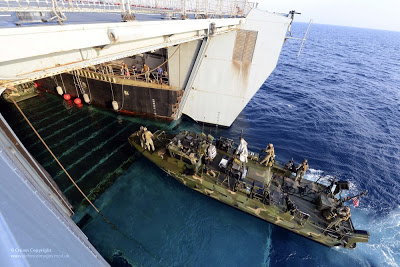
Taking the load off in the North Atlantic from 1939 to 45 (and 1914 to 18) made sense. There was a war on. Freedom of movement (both political and on the high seas) was constrained by the reality of circumstances. Absolutely no sense in building cruisers and carriers when corvettes, Liberators and Sunderlands were getting the job done.
Even during the Cold War, the threat (and looking back at it now it is harder to believe it was real) was perceived to be real enough that it made sense to function in concert with our allies.
However our current world, and the one coming, not only presents a multiverse of chaos but also an ever broadening array of opportunities for those equipped to exploit them. And what better corporate entity to exploit them than a small nation sitting on the world's largest treasure chest.
Empires are stultifying as they impose order and discipline. The precursor to the enlightenment was the destruction of imperial order by buccaneers, corsairs, privateers, pirates, sea dogs, sea beggars and Dunkirkers. The Royal Navy arose out of policing that miserable mob.
Canada doesn't have to aspire to policing the world's seas, although I believe it should contribute to the attempt. But it should aspire to being able to project force to defend Canadian interests across as much of the globe as it can and, while its at it take Canadian values and laws along with it.
That ability to act globally in a variety of scenarios (not everywhere and not in every situation) demands a general purpose, broad spectrum fleet.
Percy Nelles could rightly be accused of aggrandisement (I don't necessarily accuse him of self-aggrandisement) at an inappropriate juncture in history. On the other hand, he wasn't the first or even the only WW2 figure who kept a weather-eye on the end of the war and decided that the opportunity to make hay while the sun shone should be exploited.
Before WW2 Percy's navy was small. After WW2 Percy's navy was small. In neither period had or has the government or the navy been able to make the case to prairie farmers for the need for a naval force. During WW2, all of a sudden, prairie farmers were heading to sea in their tens of thousands. There was money to build ships.
In 1939 to 1943 the requirement was to cover the ocean with sentinels to protect the convoys (range of action was a far as a corvette could chuck a depth charge while motoring along at 16 knots). By the end of 1943, and with the Reich being put on its back foot, a case could be made for converting some of that effort into building up an independent post-war force.
Circumstances today not only permit a Broad Spectrum force, they demand it.
Your servant sir.
Edit to add a PS:
With respect to the New Zealand Flotilla I would swap the four 55m vessels for a third 85m and then equip all the ships in the flotilla with both a flight deck and a pair of CB-90s. 1x Absolon CSC, 3x Protector 1900, 8x CB-90 and a mixed air fleet ranging from Scaneagles to Cyclone/Merlins (connected to friendly shores by Chinooks) could police a very large bit of real estate.

Oldgateboatdriver
Army.ca Fixture
- Reaction score
- 4,153
- Points
- 1,010
E.R. Campbell said:Now you're talking like Percy Nelles who also wanted a big, "broad spectrum" navy and who, in my opinion, was afoolweak and misguided CNS.
What was needed, as Leonard Murray et al understood, was was absolutely essential, was to win the Battle of the Atlantic, and for that we needed a mix of those cheap, quick and dirty corvettes, frigates and aircraft (land and carrier based). Convoy escort wasn't glamorous but it was one of the three big things that Canada did that really, really mattered; the other two were industrial production and the Commonwealth Air Training Plan.
Our other naval contributions: including the cruisers, fast Tribals, and the brave motor torpedo boats were all distractions
Fully agree with the highlighted part there ... and the post in general.
BTW, another plus for the Otago's should they be put in Canadian service: Room to train reservists. Those 30 bunks for embarked force will necessarily be unused the majority of the time. That gives you 30 bunks on each ship to fill with reservists trying to get their sea time in for OJT without depriving the ships of their normal crew. If you make the normal crewing a mix of regulars and reserves, you have the perfect situation of having the regulars ensuring the maintenance of high standards and the reservist being able to demonstrate on an ongoing basis their capabilities and usefulness to the future leaders of the Navy.
Oldgateboatdriver
Army.ca Fixture
- Reaction score
- 4,153
- Points
- 1,010
Kirkhill said:Edit to add a PS:
With respect to the New Zealand Flotilla I would swap the four 55m vessels for a third 85m and then equip all the ships in the flotilla with both a flight deck and a pair of CB-90s. 1x Absolon CSC, 3x Protector 1900, 8x CB-90 and a mixed air fleet ranging from Scaneagles to Cyclone/Merlins (connected to friendly shores by Chinooks) could police a very large bit of real estate.
Unfortunately Kirkhill, the CB-90's are NOT davit carried boats They operate from wells or they could be slung from cranes on large ships - but not small ones like Otago class vessels. If you modified the Otagos to host them in a stern well, then you would have to trade in both the containerized systems AND the embarked force cabins, and then what would be the point of carrying them?
- Reaction score
- 12,038
- Points
- 1,160
Oldgateboatdriver said:Unfortunately Kirkhill, the CB-90's are NOT davit carried boats They operate from wells or they could be slung from cranes on large ships - but not small ones like Otago class vessels. If you modified the Otagos to host them in a stern well, then you would have to trade in both the containerized systems AND the embarked force cabins, and then what would be the point of carrying them?
You mean they can't be hoisted aboard like this?
The trials were conducted by the Dutch and Royal Marines with the Rotterdam. Admittedly she's a bit heavier than the Otago.
The CB90s are 13.3 tonnes dry and are 15.9m long.
Perhaps a deck arrangement more like the Damen 2600 (or even the AOPS) would be more in keeping. (Click on the OPV 2600 entry to access the PDF brochure).
Edit: Came across this tidbit on the sea-keeping capabilities of the CB-90
The LCVP MK5 can carry, at relatively good speed, some 35 soldiers or a light utility vehicle, but these capabilities are now regarded as secondary. The CB90 seats 18 Marines and takes their kit (and one of her good points is that said 18 Marines were able to all but sleep while riding out in Sea State 4, while people in a LCVP MK5 in the same sea conditions would throw up) but the RM requirement is for as few as 8, which means that some of the troops space on the CB90 in the Force Protection Craft will be likely “sacrificed” for fitting a few commodities and kit to enable longer unsupported sorties.
And there is always the pint-sized version operated by the Danes as an arctic SAR and general LCP.
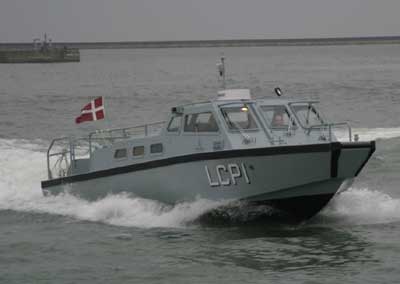
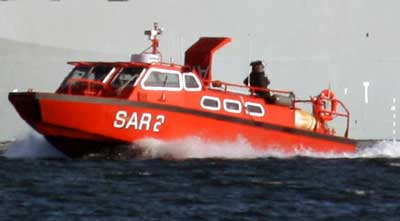
Oldgateboatdriver
Army.ca Fixture
- Reaction score
- 4,153
- Points
- 1,010
Exactly my point.
First. The Rotterdam in an amphibious assault ship that, in marine terms is eight time the size of the Otago (not quite just a bit heavier).
Second: See how she is shipped in. That is known as a Portico crane. It has two independent cranes facing one another on an I-beam. See how the forward one is rated for 10 tons and the after one for 15. They can also each be moved individually along their half of the I-beam so as to adjust to different types of objects to hoist. I suspect they could accommodate different models of LCVP's or large RHIB or two normal RHIB's.
You could easily put them on HMCS VIMY RIDGE, however
First. The Rotterdam in an amphibious assault ship that, in marine terms is eight time the size of the Otago (not quite just a bit heavier).
Second: See how she is shipped in. That is known as a Portico crane. It has two independent cranes facing one another on an I-beam. See how the forward one is rated for 10 tons and the after one for 15. They can also each be moved individually along their half of the I-beam so as to adjust to different types of objects to hoist. I suspect they could accommodate different models of LCVP's or large RHIB or two normal RHIB's.
You could easily put them on HMCS VIMY RIDGE, however
- Reaction score
- 12,038
- Points
- 1,160
I yield.... 
Suffice it to say we can afford to do a lot more with the Navy than keep Russian subs away from American carriers.
I look forward to the day that troops bounce from Trenton to Singapore to Vimy Ridge to a CSC to an OPV to a shore lodging to establish an Airhead and be resupplied by C130s and C177s
Trenton-Singapore by CC150
Singapore to Vimy by CH-147 (CH-147s delivered to Singapore by CC177)
Vimy to shore by CH-148(9) alighting on lily pads along the way.
Suffice it to say we can afford to do a lot more with the Navy than keep Russian subs away from American carriers.
I look forward to the day that troops bounce from Trenton to Singapore to Vimy Ridge to a CSC to an OPV to a shore lodging to establish an Airhead and be resupplied by C130s and C177s
Trenton-Singapore by CC150
Singapore to Vimy by CH-147 (CH-147s delivered to Singapore by CC177)
Vimy to shore by CH-148(9) alighting on lily pads along the way.
- Reaction score
- 8,530
- Points
- 1,210
Kirkhill said:I believe the problem is one of managing expectations (a problem known to everyone who has lived through Christmas) and more importantly determining whether the RCN is going to be a full service navy that permits Canada freedom of movement on the High Seas. Or is it going to continue to be an auxiliary force as it was to the RN and is now, to my eye, to the USN.
In an effort to change your perception just a few example from recent (last 20yrs) history
1991 - The Gulf War. Canada held the only non-US command for naval matters. We were in charge of the resupply lanes just outside the Straits of Hormuz including US, British, French and Argentine ships.
2001 Sept 11 - HMCS IROQUOIS was the first ship in North America to respond and cover NY airspace.
2002-3 - OP ATHENA. Canada deployed a full TG of a CC Destroyer and 2 Frigates adding in an AOR as well as MPA. The commodore was in command of a number of US ships and was tasked with protecting LPD's, LPH's etc... of the US Marine Corps as they moved troops back and forth by helo to Afghanistan
2011 Libya - HMCS CHARLOTTETOWN was in command of a NATO task group patrolling off of Libya where they became the first ship since Korea to take enemy fire.
Not to mention the War in Iraq where we were not in conflict but "helping" quite a bit with command and control of US assets again.
There are other good examples of Canadian Naval leadership or independence in action. Yes we plug into NATO and the US groupings quite a bit, but the Task Group concept is key to ensuring we are not just an auxiliary formation. This is extremely important, as demonstrated by the Australian commitment to OP ATHENA (or whatever they called it) required them to embark their TG command team aboard a US destroyer (incidentally that embarrassment and the obvious "best practice" demonstrated by the RCN lead to the requirement for the HOBART's).
The issue here is "full service". There are things we will never do because we can't afford them or have a requirement for them strategically, they are even listed in Leadmark 2020:
-Strategic attack
-Amphibious assault (vice sealift)
-Maritime pre-positioning
-Fleet Air (carrier) capability (vice organic air or helo's/UAV's embarked on smaller ships)
-Force Mine Countermeasures - aka having a ship be part of the Standing NATO Response Force Mine Countermeasures Group 1
-Offensive and defensive mine laying
-Nuclear, chemical, biological weapons
-Submarine salvage
IMHO the largest concern here is the capability gap caused by the eventual retirement of the Tribals and the timeframe for the Berlins to arrive.
As for choosing an MCDV replacement I noticed that so far all of the examples do not have a MCM or route survey capability. Mayhaps that be a requirement as well? Certainly some of the designs out there could do MCM well could they not?
- Reaction score
- 12,038
- Points
- 1,160
Underway:
I take your point and want to make it clear that I was not denigrating the work the RCN has done, is doing and is capable of doing. The RCN, like the rest of the CAF, has a long tradition of doing things with the tools at hand and not the tools they want/need.
For me the particular question is: Do you have the right array of tools available to perform the operations likely to be encountered in the (un)foreseeable future?
I don't want to deny you the tools that will permit you to continue with your current capabilties. What I would like is to modify the tools at hand to permit a greater range of utility, especially in joint operations.
With respect to the latter I have mixed feelings about Big Honking Ships because they will always be few in number, as a result will never be in the right place, will take weeks to get where they are required and make marvelous targets.
I prefer an approach that permits the RCN to contribute to the ability of the RCAF to move CA troops around the world by providing moveable heliports with short-stay hotels.
When the Army is not in residence then the RCN and RCAF can spread out and enjoy their bigger cabins.
The same heliport facilities permit crew changes / capability modifications at sea and longer times on station.
The intent is to try to add a flight deck to an MCM capable vessel and not to replace the MCM with a troop transport.
I take your point and want to make it clear that I was not denigrating the work the RCN has done, is doing and is capable of doing. The RCN, like the rest of the CAF, has a long tradition of doing things with the tools at hand and not the tools they want/need.
For me the particular question is: Do you have the right array of tools available to perform the operations likely to be encountered in the (un)foreseeable future?
I don't want to deny you the tools that will permit you to continue with your current capabilties. What I would like is to modify the tools at hand to permit a greater range of utility, especially in joint operations.
With respect to the latter I have mixed feelings about Big Honking Ships because they will always be few in number, as a result will never be in the right place, will take weeks to get where they are required and make marvelous targets.
I prefer an approach that permits the RCN to contribute to the ability of the RCAF to move CA troops around the world by providing moveable heliports with short-stay hotels.
When the Army is not in residence then the RCN and RCAF can spread out and enjoy their bigger cabins.
The same heliport facilities permit crew changes / capability modifications at sea and longer times on station.
The intent is to try to add a flight deck to an MCM capable vessel and not to replace the MCM with a troop transport.
- Reaction score
- 6,323
- Points
- 1,260
It seems to me (a landlubber) that if we decide we need mine countermeasure vessels then we ought to build a few good ones and they can, probably, also do coastal defence duties (FishPats, etc) until there are mines to counter. A helipad is not a necessity for either mine warfare coastal defence duties, as far as I can see ~ nice to have, I guess, but not a "must have."
Now, maybe we need, and can afford: (8-12) heavies + (6-10) middleweight corvettes (fast, small crews, multi-role, can carry a helicopter) + (6) AOPS + (4-8) mine warfare ships, real small combatants with small crews and no flight deck + (2 or 3) AORS + (4-6) submarines + assorted tenders and training vessels.
Now, maybe we need, and can afford: (8-12) heavies + (6-10) middleweight corvettes (fast, small crews, multi-role, can carry a helicopter) + (6) AOPS + (4-8) mine warfare ships, real small combatants with small crews and no flight deck + (2 or 3) AORS + (4-6) submarines + assorted tenders and training vessels.
- Reaction score
- 12,038
- Points
- 1,160
I generally try to stretch the planning envelope as far as I can until somebody says "You can't do that!".
Your fleet gives me 22 to 31 "lily pads" without including the mine warfare ships but including the AOPS. That works for me.
Your fleet gives me 22 to 31 "lily pads" without including the mine warfare ships but including the AOPS. That works for me.
- Reaction score
- 6,323
- Points
- 1,260
I recall, albeit through the mists of time, a rater frightening staff college discussion about mine warfare. One of our Canadians (later VAdm Lynn Mason) started by haranguing the assembled multitudes, including the guest lecturer (USN RAdm) and some other visiting firemen, for ignoring the mine threat and failing to take the (pretty cheap, especially compared to the then brand new 280s) actions (new minesweepers) needed. I recall that he and another Canadian student (Barry Ridgewell, a diver) more or less took over the USN admiral's session and scared the living you know what out of us with an impromptu lecture on what mines can (and cannot) do to us ... especially in the Straits of Juan de Fuca and in Halifax.
- Reaction score
- 12,038
- Points
- 1,160
I think the "bottom of the sea" is going to become a much more interesting place:
DARPA Falling Upwards
DARPA Hydra Drones
Add in the conventional threats like moored mines, bottom dwelling mines and captors and you are facing "brilliant" minefields over much larger areas than the traditional choke points.
On the other hand the counter battle is well underway.
MCM Drones
One of the more interesting images is of a RHIB lauching an MCM AUV.
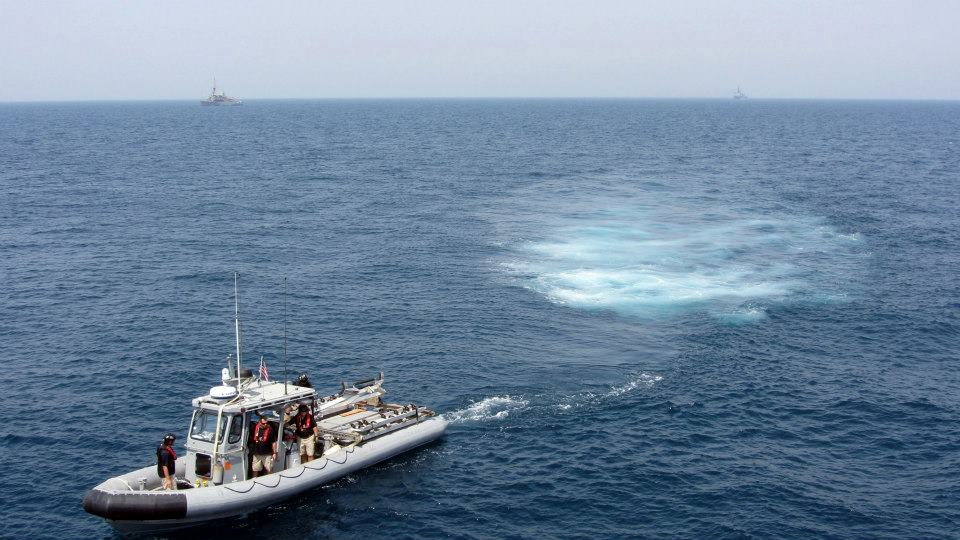
To return to something that OGBD said about having to choose between a stern trawlway and a working deck - I return to the Black Swan concept
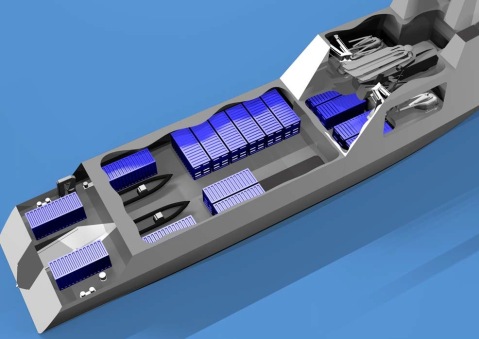
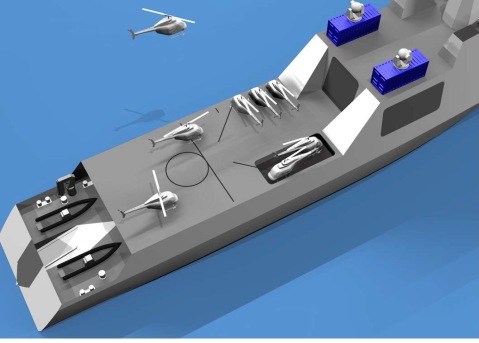
That's with a designed beam of 15.5 m vice the 11.3 m beam of the Kingstons and the 14.6 m beam of the Rasmussens (which also use stern recovery for their SAR boats).
DARPA Falling Upwards
DARPA Hydra Drones
Add in the conventional threats like moored mines, bottom dwelling mines and captors and you are facing "brilliant" minefields over much larger areas than the traditional choke points.
On the other hand the counter battle is well underway.
MCM Drones
One of the more interesting images is of a RHIB lauching an MCM AUV.

An 11 meter Rigid Hull Inflatable Boat launched from Afloat Forward Staging Base (AFSB) Interim (I) USS Ponce equipped to carry the Mk 18 Mod 2 Kingfish mine hunting UUV. ( U.S. Navy photo by Chief Aerographer's Mate Jamie McClain/Released)
To return to something that OGBD said about having to choose between a stern trawlway and a working deck - I return to the Black Swan concept


That's with a designed beam of 15.5 m vice the 11.3 m beam of the Kingstons and the 14.6 m beam of the Rasmussens (which also use stern recovery for their SAR boats).
MilEME09
Army.ca Fixture
- Reaction score
- 6,625
- Points
- 1,210
This article has some weight here so revive.
Two more navy defence ships taken out of service
http://www.ctvnews.ca/canada/two-more-navy-defence-ships-taken-out-of-service-1.1571859
five ships total are now docked due to budget cuts. Which ships and which coasts is unknown
Two more navy defence ships taken out of service
http://www.ctvnews.ca/canada/two-more-navy-defence-ships-taken-out-of-service-1.1571859
Two military coastal defence ships have quietly been taken out of service in an effort to cut costs, CTV News has learned.
The Maritime Coastal Defence Vessels were docked as a cost-saving measure, according to the Department of National Defence.
In total, five navy ships are no longer patrolling Canada's coasts.
Related Stories
Defence bureaucracy still bloated 2 years after report
DND to 're-examine' cut to danger pay for troops in Afghanistan
DND HQ admin costs rising, despite pressure to cut back: PBO
In a statement to CTV News, the DND said the vessels' activities have been reduced for the short-term, "resulting in cost-savings related to operational maintenance and in-service support related expenditures."
"Defence experts that I've spoken to are questioning how this is going to affect the navy's operations," CTV's Mercedes Stephenson told News Channel on Tuesday. "The navy maintains that there will be no impact on maritime security, even though they will have two fewer ships."
In 2010, the head of Canada's navy ordered half of the country's maritime coastal defence vessels to be docked indefinitely, but the decision was reversed following intense political pressure.
The navy operates 12 Kingston-class vessels, but only seven are currently operational.
The ships are responsible for patrolling Canada's coasts, enforcing fisheries laws and participating in search-and-rescue operations.
The latest cuts mean that one less ship will be patrolling each coast.
five ships total are now docked due to budget cuts. Which ships and which coasts is unknown
Similar threads
- Replies
- 154
- Views
- 9K
- Replies
- 42
- Views
- 7K
- Replies
- 0
- Views
- 2K


